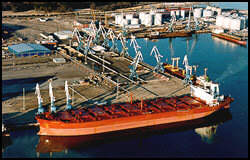 Infrastructures Infrastructures |
The telecom sector is a big business in Estonia. The country is 99% covered with mobile GSM networks. Fixed lines lead to almost every household and company. The quick development started at the beginning of 1990s, when the government agreed upon a concession with Nordic telecommunication companies. On one hand the agreement prevented competition in the fixed line telephone business, on the other hand it helped to change the old telephone lines into new fiber-optic information highways. During the Soviet years owning a phone at home was a real luxury. You had to be a member of the Soviet high-ranking nomenklatura to get a phone when you needed one. All the others were put on waiting lists which stretched 20 years.

From the beginning of next year the fixed line telephone market will be open to competition. "We have a telecommunication monopoly and now it would be good to break it. With the help of telecommunication regulations we hope to get more competition on the market. We should discriminate a bit on the monopoly," says Toivo Jürgenson, Minister of Transport and Communications.
In spite of tough competition in the mobile communications
market, the most successful part of Estonian Telecom
is AS Eesti Mobiiltelefon (EMT, The Estonian Mobile
Phone Company). It is far ahead of the other two
main competitors. EMT is the first in the world
to introduce mobile positioning service. The CEO
of EMT Peep Aaviksoo has an explanation to Estonia's
high penetration of mobile technology: "People
here are driving good cars, most have mobile phones
and wear good clothes. People work hard to get better
things." |
Besides telecommunication the other key sector in Estonia's economy is "land communication", namely road transport, railways and ports. In the transport sector the transit from Russia is the most important, it embraces 10-15% of GDP. The main part of transit is from East to West. More than a half of the amount is the transit of oil from Russia to the West.
Tallinn is the fastest growing port in the Eastern Baltic Sea. The reason, as analysts describe, is that the Tallinn Port is very efficient and very cost effective. Finnish ports cannot compete with Tallinn in the cost point of view.

"During the last 3 years we have increased our volumes on average by 25%, this year during the first 3 months compared to the last year we have an increase of 36% already," describes Riho Rasmann, the CEO of the Port of Tallinn. In March this year he visited all the important US ports from Miami to Baltimore. The aim is to create a kind of direct cargo flow from the US to Russia.
One of the most successful companies, that has taken advantage of Estonia's good geographical position is N-Terminal. The company's philosophy is to offer a business environment for Russian oil producers. "We understand the demands quicker," says CEO Endel Siff explaining the company's comparative advantage. Just now Siff is looking towards the possibilities of Internet as a tool for bringing together producers and buyers. At the moment Siff is searching for reliable partners in the US Silicon Valley. Siff is optimistic about the future: "We have an American way of thinking inside socialized Europe." |

